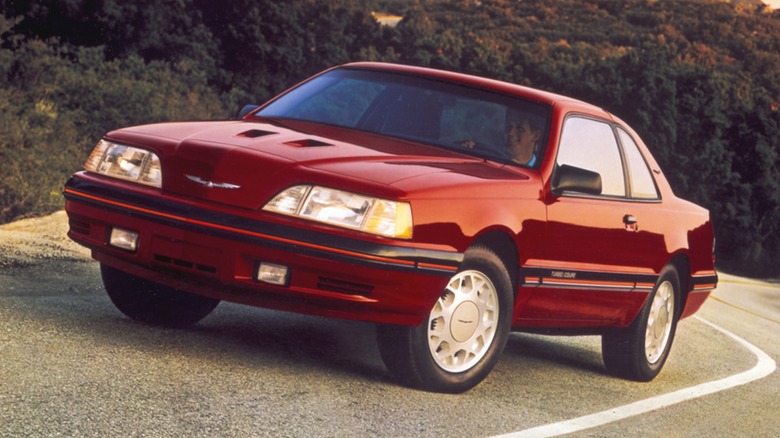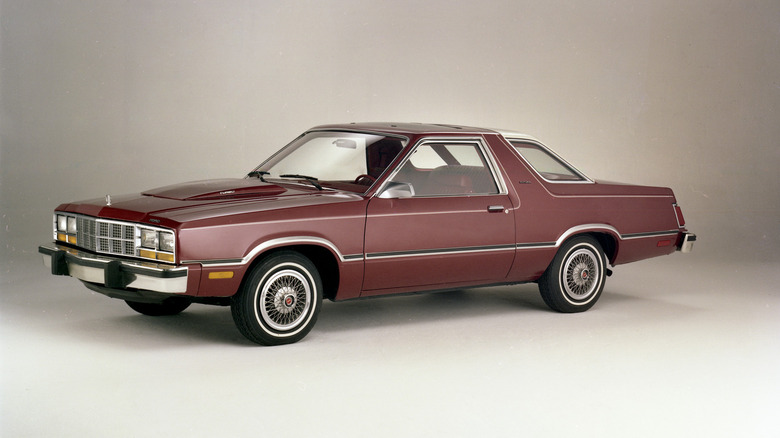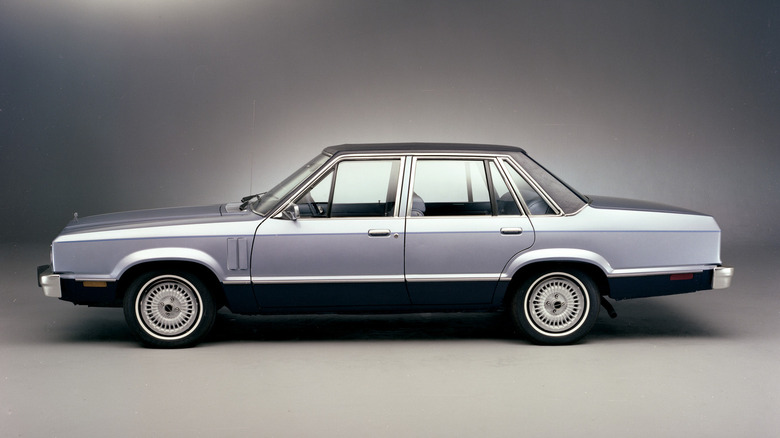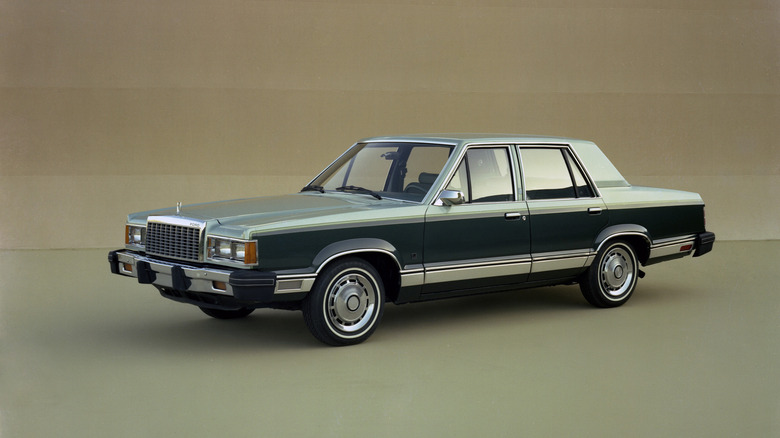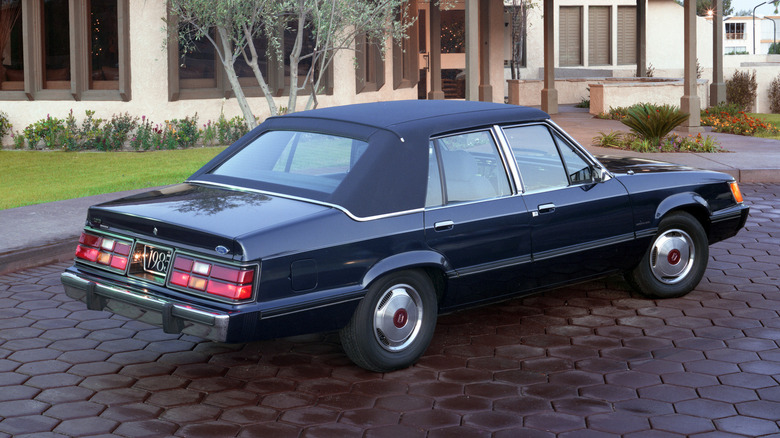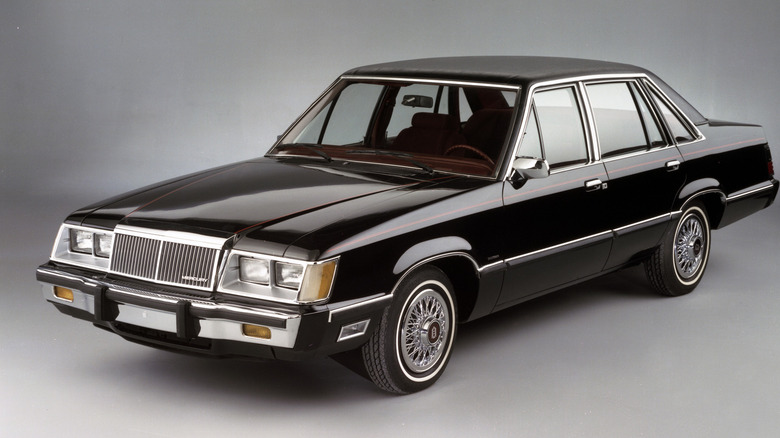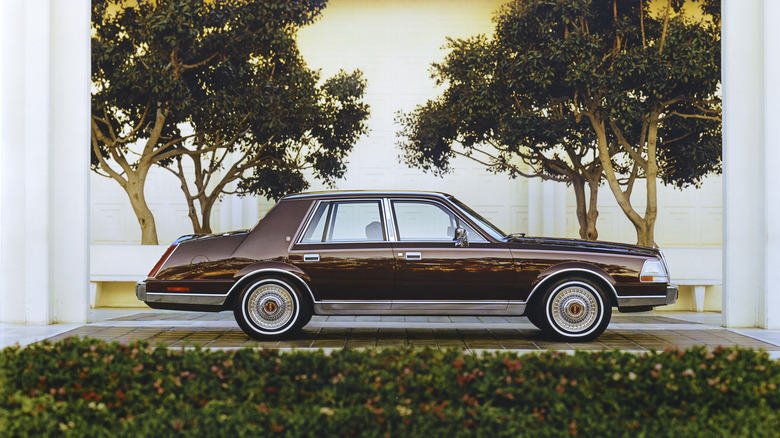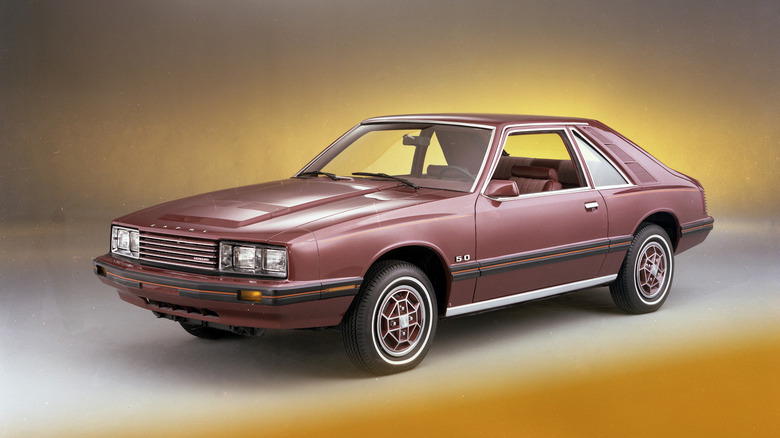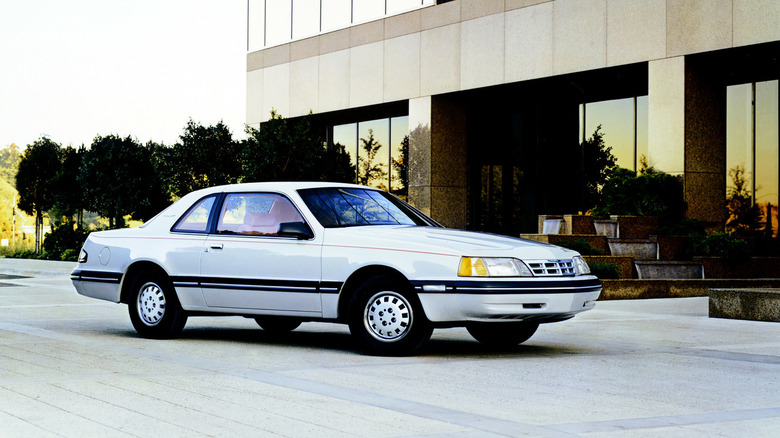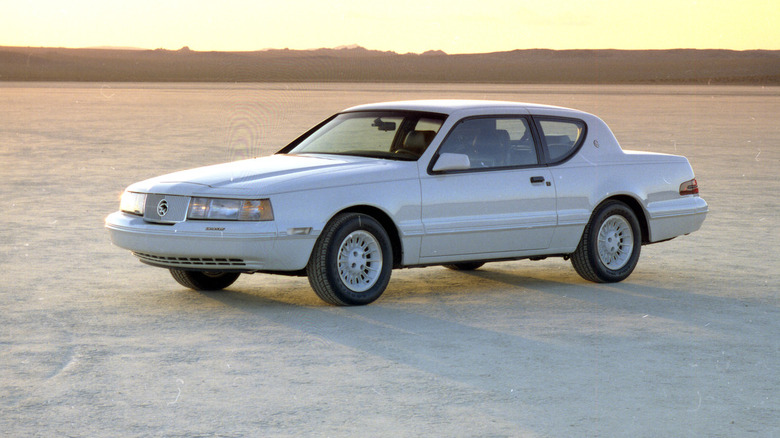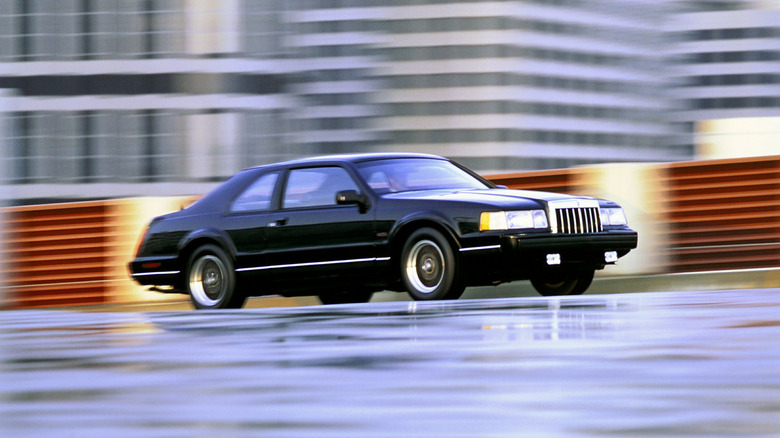10 Fox Body Cars That Aren't A Ford Mustang
The year 1973 marked a turning point for the American automotive industry, after which things would never be the same. Starting in October of that year, OPEC began tightening oil exports to the United States and other countries, and by December, it had imposed a total ban on oil sales, causing the price of oil to quadruple. It was an economic catastrophe for the U.S., where cheap oil prices had meant size and fuel efficiency had been minor factors in car design. Yet Ford had been one step ahead of the game all along.
In 1972, Ford insiders noticed spot shortages at gas stations and took action to prepare the company for a future of expensive fuel, not knowing how prescient they would prove to be. They launched the Product Planning and Research (PPR) division to devise a strategy. One of the PPR's conclusions was the need for Ford to develop a common platform to meet future requirements for smaller, more efficient automobiles that would be cheaper to design and build. Thus, the Fox body platform was born.
The goal with the Fox project was to create a platform that provided a base for several models ranging from small sports cars to sedans, wagons, and personal luxury coupes. The most famous Fox body car would prove to be the Mustang because of its popularity and the fact that Mustangs rode the Fox chassis from 1979 until 1993, achieving a nearly legendary status among enthusiasts. Indeed, the current value of Mustangs from the Fox body years is rising. Yet close to a dozen other models from Ford, Lincoln, and Mercury were Fox bodies under the skin, including a few that might surprise you.
1978-1983 Ford Fairmont
The 1978 Ford Fairmont introduced the world to the Fox body platform, along with its Mercury Zephyr counterpart. It seemed like the perfect car for its time, and initially it was a huge sales success, becoming one of the best-selling debut models in Ford's history. Yet by the time Ford cancelled the Fairmont in 1983, sales had trailed off, and the car faded into obscurity. Yet, as Ford's first Fox body, arriving a year earlier than the Fox Mustang, it holds a special place in the company's history.
Reviewers were impressed by the Fairmont, although with reservations, mostly about its very conservative, square-edged style. The model they reviewed was arguably one of the most underrated Ford vehicles powered by the Windsor 302 V8 engine, although it was a version with only 139 horsepower. Still, in this relatively lightweight, 3,000-pound car, that engine was good for a 13.7-second 0-60 run — not particularly bad for a Malaise Era automobile, but hardly a neck-snapper.
Road Test magazine found a four-cylinder, manual-transmission-equipped model to be fun in a minimalist way. A 3.3-liter inline six-cylinder making 85 horsepower was also available. The Fairmont came as a sedan, a wagon, and a coupe called the Fairmont Futura. The latter, with its dramatically styled, forward-leaning B-pillar, gave the Fairmont an element of visual pizzazz lacking in the sedan. Almost five decades on, Fairmonts make good project cars for enthusiasts looking for an alternative to increasingly pricey Fox-body Mustangs.
1978-1983 Mercury Zephyr
Like its Ford twin, the Mercury Zephyr arrived in 1978 to great fanfare as a solution to the problem of comfortable, efficient, mainstream transportation. Its lightweight, unibody construction contributed to decent handling compared to the land yachts that ruled the earlier part of that decade, while not being just a scaled-down version of existing platforms. The Fox body was a clean sheet of paper design, making the Zephyr, like the Fairmont, competitive with imports as well as less sophisticated small-car platforms from its Detroit rivals.
Also like the Fairmont, the Zephyr offered a choice of four, six, or eight cylinders. In front, it featured beefed-up McPherson struts to help handle the weight of the optional V8. Computer modeling and wind tunnel testing helped create a refined and quiet ride and boost fuel efficiency. Reviewers found the Zephyr's handling to be a cut above most American sedans. Its appearance was very similar to the Fairmont, aside from trim pieces, giving it a stately, squared-off appearance that's visually reminiscent of larger cars.
In a further similarity with the Fairmont and its Futura derivative, the Zephyr was available as a two-door coupe model called the Z-7. It had the same basket-handle B-pillar as the Futura. In fact, aside from some trim pieces, almost the only visual distinctions from the Futura are the short vertical strakes behind the front wheel arches. Still, both the coupe and the sedan were handsome cars for their day, and since Ford ended the Mercury brand in 2010, they hold a certain nostalgic appeal.
1981-1982 Ford Granada
The Ford Granada was born in 1975 on an old platform dating to 1960, and by the dawn of the '80s, it was ready to be modernized and downsized. Thus, in 1981, it moved to the Fox platform. The new Granada looked very similar to its Fairmont stablemate, although Ford positioned the Grenada as a midsize car compared to the Fairmont, despite the fact that it was only an inch shorter and shared the same wheelbase. Still, the Fox-based Granada was 400 pounds lighter than the big, floaty 1970s model that it replaced. Plus, according to Ford's advertisements, it achieved 34 mpg on the highway.
The ads touted the '81 Granada's other improvements, including rack-and-pinion steering and a revised suspension. Despite its smaller dimensions, Ford claimed more interior room than the previous-generation sedan. It was available as a two-door, a four-door, or a wagon. Colors included "Medium Fawn Glow." Engine choices included a 2.3-liter four-cylinder, a 3.3-liter inline six, and a 4.2-liter V8.
Ford positioned the Granada between the Fairmont and the LTD, the latter of which still rode on the Panther platform. The Granada's 105-inch wheelbase was similar to the Fairmont's, so most of the difference in size came down to the sheet metal, but even so, many of the body panels were shared between both models. It was also a rear-wheel drive, medium-sized car when GM and Chrysler were introducing front-wheel drive small car platforms. Sales were mediocre, and the Fox-body Granada was replaced with a new Fox-based LTD after only two years.
1983-1986 Ford LTD
In 1983, Ford shook up its sedan lineup. The Fairmont was in its final model year, while the LTD nameplate, formerly affixed to a full-sized Panther platform model, was transferred to a new Fox-body model to replace the Granada. That Panther platform sedan still existed, but was renamed as the LTD Crown Victoria, and would eventually become simply the Crown Victoria in 1992. Ford announced right from the start that the new LTD would only exist through the 1986 model year, promising that it was a preview of a new direction for the company, a direction that would lead to the 1986 Taurus.
If this lineup shuffle sounds confusing, it's worth noting that the whole American auto industry was in a transitional state. As we saw with the LTD's predecessor, the Granada, Ford was reacting to shifts in its rivals' product strategies. GM was downsizing and planned to shift to front-wheel drive, and Chrysler was shifting to smaller, front-wheel drive cars. Both of Ford's rivals were also moving the names of full-size cars like the Pontiac Bonneville and Chrysler New Yorker onto smaller sedans. Ford's strategy with the LTD was intended to keep pace.
Despite being a transitional model, the new LTD was moderately successful. Part of this can be chalked up to the LTD LX, a four-door sleeper of a Mustang clone. It sported a Mustang GT suspension and the high-output 5.0-liter Mustang V8. This engine featured a Holley four-barrel carb and produced 175 horsepower — not a huge amount by today's standards, but as America was coming out of the oil-shock era, it was a real taste of performance, especially in a lightweight, Fox-body car. Combined with snappy blackout trim, the LTD LX was a legitimate sports sedan.
1983-1986 Mercury Marquis
The Mercury Marquis followed the same trajectory as the Ford LTD twin, going from a full-size, old-fashioned American luxury sedan to a midsize Fox-body car. Like its Ford counterpart, a game of names took place, with the Marquis moniker being shifted from the Panther platform to the new Fox model, while the old Panther-based car became the Grand Marquis. Mercury still pitched the (non-Grand) Marquis as a luxury car, with an ad depicting the sedan resting on its own velour seats and touting its quiet cabin and serene ride.
Oddly for a luxury-oriented car of that era, the Marquis offered no V8 model. Instead, its engine lineup consisted of a 2.3-liter four-cylinder, a 3.3-liter inline six, and the Ford Essex 3.8-liter V6 engine. The latter was a Canadian-built motor that produced 120 horsepower, making it competitive with V8s of the day. The 1984 and 1985 models would offer a 5.0-liter V8 model. The Marquis was available as a four-door sedan in regular and Brougham trim levels and as a wagon in regular and Brougham models, with the Brougham offering wood-grain siding.
1982-1987 Lincoln Continental
From the time the Lincoln-Zephyr Continental went into production in 1939 until Lincoln discontinued the Continental for reasons of poor sales and the public's increasing preference for SUVs in the early 2020s, Ford produced 10 generations of the storied model. There were even times when all Lincolns were Continentals. The nameplate became a byword for American luxury sedans, and during its seventh generation from 1982 to 1987, it was a Fox-body car.
This version of the Continental was distinguished by a handsome, square-edged design with one controversial feature: the bustle-back. Echoing earlier European designs, this trend revived in the early 1980s with models from Cadillac and Chrysler, leaving Lincoln to play catch-up. A bustle-back is a short trunk lid with a sloping rear vertical surface, and Lincoln's interpretation incorporated a spare tire bulge. It wasn't every luxury car buyer's cup of tea, but it certainly helped the Continental (and its rivals) stand out in an era of understated design.
The bustle-back Continental has become something of a collector's item, although at reasonable prices (so far). In 2021, a one-owner Continental in a fetching two-tone blue color scheme with only 17,000 original miles sold for $25,000. This car came equipped with a 302 V8 that produces 131 horsepower and a passably decent 229 lb-ft of torque. It also came with the full suite of Continental features, including blue leather upholstery, a power sunroof, power seats, wire wheels, and a digital dashboard — true luxury by early '80s standards.
1979-1986 Mercury Capri
The first-generation Capri was an unbranded car sold through Lincoln-Mercury dealers from 1970 through 1977. That Capri was what Ford made originally for Europe as a consolation prize for the Mustang not being available on that continent, although the company then decided Americans should get the small, sporty Capri coupe, too. When the Mustang was moved onto the Fox platform in 1979, Mercury got its own version, and the second-generation Capri became a Fox-body car.
The new Capri was very similar to its pony-badged cousin, although there were a few visible differences. It wore a vertical, horizontally straked grille versus the Mustang's sloping, egg-crate grille, and the Capri sported understated box flares in the fenders and quarter panels, as opposed to the flares that traced the shape of the Mustang's wheel arches. The Capri was only available as a hatchback, lacking the notchback body available on the Ford version. The Capri lasted through the 1986 model year, whereas the Mustang is still going strong today. This, combined with the fact that the Capri was almost an afterthought for car buyers, means the Mercury pony car is rare and collectible today.
Under the hood, engine choices were very similar to the Mustang. They included inline four-cylinders in regular and turbo flavors, an inline six, and a pair of V8s. The 2.3-liter Turbo RS model was considered the sportiest Capri in 1983 with 130 horsepower, a testament to the lowered expectations of sports car buyers in the early 1980s. But eventually the RS trim would get the 5.0-liter V8, and limited-edition models tuned by ASC would produce as much as 210 horsepower. The 1985 ASC/McLaren Capri, in particular, is one of the classic Mercury models worth every penny.
1980-1988 Ford Thunderbird
Here's a Ford Thunderbird fun fact every enthusiast should know: There have been 11 generations of the iconic T-bird since its introduction in 1955. For its eighth generation, which debuted in 1980, Ford moved the Thunderbird to the Fox platform. This was a significant downsizing, knocking off more than a foot in length and a whopping 700 pounds in weight. The public wasn't enthused by the svelte new coupe; Sales dropped by half from the previous seventh-generation Thunderbird, which had been the best-selling T-bird of all, moving almost a million units in just three years. By contrast, in 1980, Ford sold just over 150,000 of them.
By 1982, it sold just 45,000. However, Ford would rectify many of the Fox-body Thunderbird's shortcomings with the ninth generation, which ran from 1983 to 1988. This was an all-new car aside from the platform that it rode on, and it represented a major break with the past and a preview of Ford's future. Its sleek new shape became known colloquially as the Aero Bird. Engines included a 110-horsepower 3.8-liter V6 and a 140-horsepower 5.0-liter V8. But the real star was the Turbo Coupe. Starting with 145 hp from a turbocharged 2.3-liter four-cylinder in 1983, power climbed to 155 hp in 1985, then jumped dramatically to 190 hp and 240 lb-ft of torque for 1987 and 1988.
Sales jumped immediately and continued to climb from there. In fact, the restyled Thunderbird became one of Ford's best sellers for the remainder of the decade. It helped that NASCAR driver Bill Elliot set a long-standing speed record at Talladega in a T-bird-bodied car, and that the street version offered a smooth ride and good handling, thanks to its Fox-body underpinnings.
1980-1988 Mercury Cougar XR-7
Like its Thunderbird counterpart, the Mercury Cougar XR-7 was downsized onto the Fox platform in 1980. For the 1982 model year, the Cougar was also available as a sedan, a non-XR-7 coupe, and a wagon, but the XR-7 offered a feature that made it stand apart from other Cougars: a longer wheelbase. At 108.4 inches, it was longer than the 105.5-inch wheelbase of regular Cougars. This allowed Mercury to hang longer sheet metal on it, resulting in 200.4 inches of overall length versus the run-of-the-mill Cougar's 196.5 inches.
Both were huge reductions from the 1979 non-Fox model's 114-inch wheelbase and 215-inch length, and the changes weren't universally well-received. In fact, the 1980 to 1982 Cougar has been almost forgotten. However, in another parallel with its T-bird cousin, the Cougar received a complete restyle and a thorough rebirth for 1983. Yet it also maintained a distinctive profile. Whereas the Thunderbird was all one long sleek curve from nose to tail, the Cougar had a more upright, formal-looking greenhouse with a notchback rear window and an upward-curving rear quarter window. The result wasn't necessarily to everyone's taste, but in an era of bland and boxy cars, the Cougar stood out. Sales boomed to 130,000 per year, a big seller by Mercury's standards.
The XR-7 trim disappeared for a year and returned in 1984, but since all Cougars now rode the same 104-inch wheelbase, the designation didn't mark a separate model as it had from 1980 through 1982. The 2.3-liter turbo four in the XR-7 generated 145 horsepower, while the 3.8-liter V6 and 5.0-liter V8 were available in other trims. By 1987, the turbo was up to 155 horsepower, and the V8 produced 150 horses.
1984-1992 Lincoln Continental Mark VII
Staid Lincoln, known for floaty luxury cars, took a turn toward performance in 1984. That was the year the Continental Mark VII was introduced, riding on the Fox platform. From 1986 onward, it would be called just the Mark VII, a distinctively luxurious-sounding name. Its appearance was similar to the Thunderbird of that era, but with a hint of the bustle-back from the Continental sedan and a spare tire bulge in the rear deck lid. It also featured Lincoln's upright grille and lots of chrome trim, to remind buyers that this was to be considered the ultimate American luxury coupe.
Although this Lincoln wore unusually aggressive sheet metal, under the hood, it was initially a bit tame. In its first two years, engine choices were a 145-horsepower, 5.0-liter V8 or a turbodiesel supplied by BMW, of all companies. By comparison, the 5.0-liter V8 was up to 175 horsepower in Mustangs of the same model years. However, by 1987, the Mark VII LSC was up to 225 horsepower from an electronically fuel-injected version of the V8, making it competitive with European rivals at half their price.
A Car and Driver review of the 225-horsepower 1987 LSC model yielded an 8.0-second 0-60 time, faster than a Porsche 944. The piece notes that sales of the Mark VII were strong, outselling rival luxury coupes from GM and putting the sporty Lincoln in competition with imports. The review concluded that "the LSC is plenty good enough to hold its own for a few more years." It would do so, all the way to 1992.
